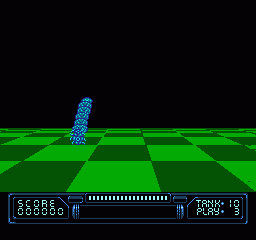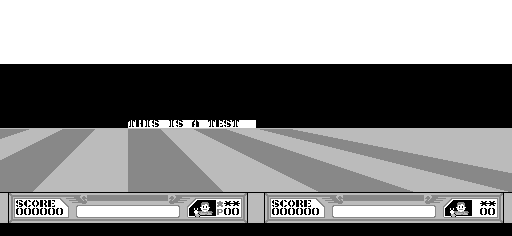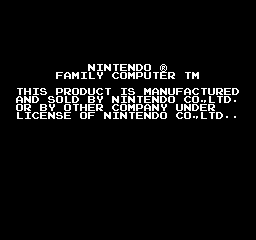The 3-D Battles of World Runner
| The 3-D Battles of World Runner |
|---|
|
Also known as: Tobidase Daisakusen (FDS), 3-D World Runner (US box art), JJ: Tobidase Daisakusen Part II (Famicom)
|
| To do: Document the weird reskinned Famicom cartridge version. |
The 3-D Battles of World Runner is one of those Square games that wasn't an RPG.
Contents
Test Background
The string "THIS IS A TEST" can be found in the non-parallax area of the game's background tilemap in ROM. This is actually copied to VRAM along with the floor and status bar, but is overwritten with the normal stage background before it can be seen. It is possible to sometimes see this if only part of the disk is corrupted.
Anti-Piracy Message
Unlike the similar copy protection features of Final Fantasy, removing Nasir's name from the in-game demo will not make the game crash. Instead, a simple copy-protection trick is used. The FDS version's file system contains two main executable files – the first is just a small piece of code that displays the message at left, and then goes into an infinite loop, while the second is the main executable and is hidden. Because the latter's index is higher than the disk system area value (which represents the maximum number of files on the disk), it appears to be "missing" from the file system. Any program or device which enumerates the files on the disk based only on the system area value (including the FDS bios) will skip this file and never look for it.
As such, most game copiers will load only the small executable, and most who try to copy the disk will see the message after pressing Start on the title screen, and then switch the disk to Side B.
With regard to normal operation, if the game has been copied properly (or the user has a genuine copy), the small executable will be rewritten with the larger one; the smaller file will not even appear in memory.
FDS Leftovers
3D Mode Switch
Game Genie code AAEAGENY (Japanese cartridge) or NYEAGAAE (US) will re-enable the 3D mode select switch. To change the default 3D-mode for each version, hold B then press Start at the title screen. The default 3D mode for the US version is red/green-colored frames (like the FDS version), while the default for the Japanese version is uncolored frames.
| US (uncolored 3D mode) | Japan (colored 3D mode) |
|---|---|
 |
 |
FDS Disclaimer
Bizarrely, the standard Famicom Disk System game startup disclaimer is present in the US and Japanese cartridge versions. In the US version, it can be re-enabled with the Game Genie code OZEAAAAV (or replace the byte at ROM address 0x4010 with A9), but for the Japanese cartridge it requires more patching: at ROM address 0x4015, replace the bytes 20 80 80 60 with A9 81 85 01, and at 0x40C8, replace 00 with 0A. (This last byte tells the NES to keep the screen disabled even after the graphics, nametable data, and palettes are uploaded, so it seems Nasir really didn't want anyone to see this screen.)
- Pages missing developer references
- Games developed by Square
- Pages missing publisher references
- Games published by DOG
- Games published by Acclaim Entertainment
- NES games
- Famicom Disk System games
- Pages missing date references
- Games released in 1987
- Games released in March
- Games released on March 12
- Games released in December
- Games released on December 7
- Games released in September
- Games with unused graphics
- Games with regional differences
- Games with revisional differences
- Games with anti-piracy methods
- Pages with a Data Crystal link
- To do
Cleanup > Pages missing date references
Cleanup > Pages missing developer references
Cleanup > Pages missing publisher references
Cleanup > To do
Games > Games by content > Games with anti-piracy methods
Games > Games by content > Games with regional differences
Games > Games by content > Games with revisional differences
Games > Games by content > Games with unused graphics
Games > Games by content > Pages with a Data Crystal link
Games > Games by developer
Games > Games by developer > Games developed by Square Enix > Games developed by Square
Games > Games by platform
Games > Games by platform
Games > Games by publisher > Games published by Humming Bird Soft
Games > Games by publisher > Games published by Micro Cabin
Games > Games by publisher > Games published by Square Enix > Games published by Square
Games > Games by publisher > Games published by System Sacom
Games > Games by publisher > Games published by T&E Soft > Games published by Xtalsoft > Games published by DOG
Games > Games by publisher > Games published by Throwback Entertainment > Games published by Acclaim Entertainment
Games > Games by release date > Games released in 1987
Games > Games by release date > Games released in December
Games > Games by release date > Games released in December > Games released on December 7
Games > Games by release date > Games released in March
Games > Games by release date > Games released in March > Games released on March 12
Games > Games by release date > Games released in September
The Cutting Room Floor > Unimportant Awards > NES games
The Cutting Room Floor > Unimportant Awards > NES games > Famicom Disk System games



